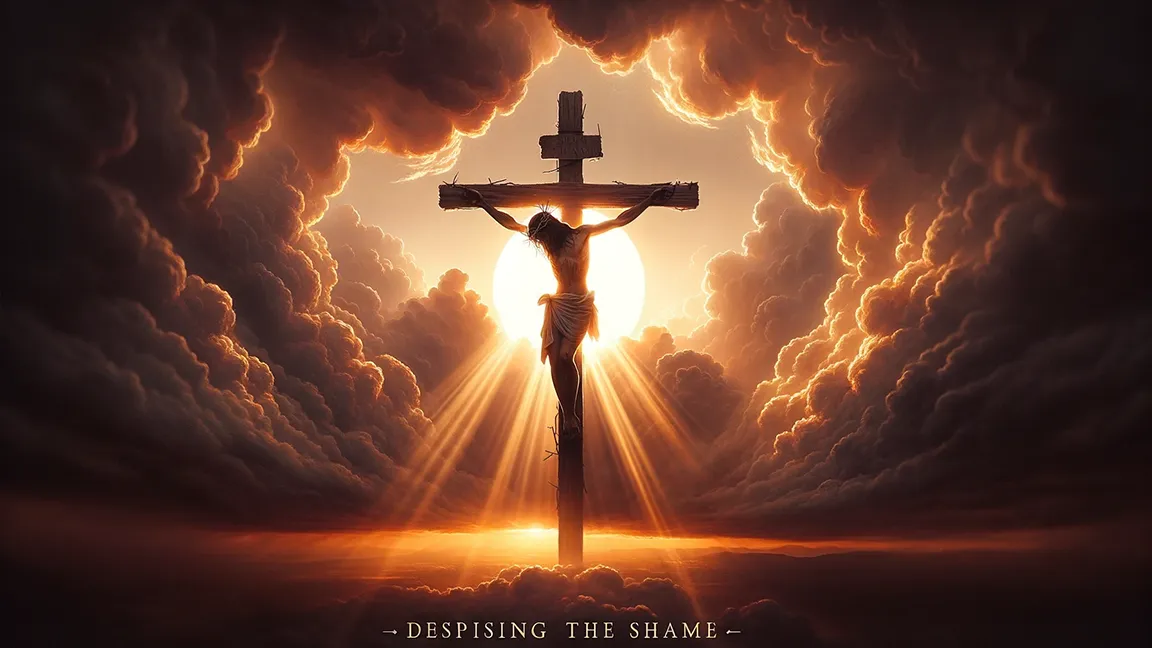Despising the shame

“He made Him who knew no sin to be sin for us that we might become the righteousness of God in Him” (2 Corinthians 5:21).
As we approach Easter Sunday and celebrate the death of death in the life of the Resurrection of Jesus, we come to this great day through the path of Good Friday. On Easter we celebrate the resurrection; on Friday we contemplate the meaning and implications of His death. It is good for us to slow down and journey with Jesus, as it were, in His work on our behalf so as to absorb the story and the verity therein as it pertains to His mission of rescuing us from our sin and reconciling us to God.
As we take time to reflect on Good Friday, we consider the cross, where the love of God towards sinners was expressed in the wrath bearing obedience of His Son. There are numerous ways we can go with such a massive topic. For instance, the cosmic plan of redemption, and how God brought it all to pass just as He intended (Acts 2:22-24; 4:27-8), the spectacle and injustice of how His trial was handled, and on and on and on.
In this post, I want to address the nakedness of Jesus and what can be theologically deduced from it.
Jesus was crucified naked
It seems most renderings of Jesus on the cross have His loins covered, but it seems that in all actuality He would have been naked on the cross. It has been pointed out that for Jewish sensitivities a cloth may be provided so as to reduce the sense of shame that was certainly intended in the act of crucifixion. Yet it hardly seems from the Gospels that this would have been a concern of the Jews who could have influenced such a thing, but rather that they did not want His Jewishness to be an issue (John 19:21). I am of the opinion that Jesus was absolutely naked as He hung on the cross as was the Roman custom.
All of the Gospels speak of Him being stripped and beaten (Matthew 27:28, 35; Mark 15:24; Luke 23:34; John 19:23). I admit there is no scholarly consensus as to whether Jesus retained an article of clothing or not. Yet upon reading John 19:23-4, the evidence seems to point to the absolute nakedness of Jesus.
“When the soldiers had crucified Jesus, they took his garments and divided them into four parts, one part for each soldier; also his tunic. But the tunic was seamless, woven in one piece from top to bottom, so they said to one another, ‘Let us not tear it, but cast lots for it to see whose it shall be.’” This was to fulfill the Scripture which says, “They divided my garments among them, and for my clothing they cast lots.”
Several important things here are to be noted. First of all His garments were divided and His tunic was attained by the casting of lots. Secondly, this was done in fulfillment of Scripture. The Scripture that is being fulfilled is Psalm 22:18. For a more detailed treatment of the grammar and literary issues involved in interpreting this fulfillment formula, I would point you to the work of Carson.¹
Nakedness in the Bible
The Roman reason that Jesus was crucified naked was to utterly humiliate Him, cause Him to feel shame and abandonment and warn the onlookers of the cost of crime and rebellion in Rome. That is the historic reason. Yet, I would also suggest that we can deduce a theological point from understanding how nakedness is treated in the Bible.
A sign of innocence
In Genesis when God made the world, He made man and gave Him dominion over the world and commanded him to inhabit and fill it. There is an interesting phrase about Adam and Eve that is a shadow of the darkness to come after the fall. Before they fell into sin, it says of them in 2:25, “And the man and his wife were both naked and were not ashamed.”
The implication is that in the original innocent state of mankind, nakedness was normal and was a sign of innocence. There was no need to hide or avoid physical vulnerability because there was no sin in the world and thus no guilt and no sense of separation. To be naked and not ashamed was to be in a state of innocence. While it is not the nakedness that is the main issue, but the heart’s relation to God, it is clear that nakedness is equated with the original state of man, as was innocence and the two are used in harmony to describe man before sin came into the world.
A sign of guilt and shame
The sign of purity very quickly becomes a sign of sin due to the fact that man becomes a sinner by virtue of disobeying the command of God. Now the natural constitution of man is no longer purity, but defilement, corruption and separation. Now man who once operated in his natural state with no sense of shame has a deep sense of shame in his natural state because his natural state is now sin. His nature has changed dramatically. Nakedness is what man is. It was innocence, but now it is guilt. Thus when we see man fall into sin, nakedness is now embarrassing, awkward, and a sense of separation and avoidance have replaced the purity of freedom and unhindered fellowship.
“Then the eyes of both were opened, and they knew that they were naked. And they sewed fig leaves together and made themselves loincloths. And they heard the sound of the LORD God walking in the garden in the cool of the day, and the man and his wife hid themselves from the presence of the LORD God among the trees of the garden. But the LORD God called to the man and said to him, ‘Where are you?’ And he said, ‘I heard the sound of you in the garden, and I was afraid, because I was naked, and I hid myself'” (Genesis 3:7-10).
Their sense of separation was immediate, and they sought to remedy the problem with urgency. Their connection to God has been broken, and now they fear Him and hide from Him. Their nakedness now represents their sinful state and separation from God. Nakedness is associated with guilt, which comes from sin. As Matthews points out how nakedness operated with a negative connotation in the Pentateuch and that the Hebrews associated it with guilt.²
There are also a few New Testament passages that may add to this theme as well (2 Corinthians 5:3; Revelation 3:17), although they are less obviously implicit than the ones noted above.
The nakedness of Jesus
In view of what has been seen about nakedness, several valuable observations can be seen about the nakedness of Jesus:
His Humanity and Humiliation
When we picture Jesus hanging naked on the cross, there we seen Him in His true and raw humanity. As one of us, He died for us. There He experienced our shame and beyond that the agony of bearing our sin for us. He was gathering up our humanity in Himself and presenting it to God. His pain was real. His blood was real. His wounds were real. His thirst was real. There was nothing easy about what He endured. And as Paul said, it was His humility (Philippians 2:8) that caused Him to endure the cross. Rome wanted to humiliate Him in His nakedness, but it was His own humility there to be seen in the most raw and vulnerable conditions humans know… nakedness.
His Innocence and Identification
In seeing how nakedness both conveys innocence and sin, we can look at our naked Savior on the cross and see how He was both. His nakedness spoke of His innocence as the last Adam and simultaneously of the sin that was placed on Him from the people of the first Adam. Adam experienced shame in the garden and exchanged an innocent nakedness for a guilty nakedness. Jesus, the last Adam, despised the shame as He in our likeness suffered for our shame and nakedness. He was simultaneously innocent and bearing our sin. He, though innocent, identified with our fallen humanity and redeemed us.
Hanging naked in His innocence, He was clothed with our sin, that we in our guilty nakedness may be clothed with His righteousness.
Paul has this exchange in mind in several passages:
“For our sake he made him to be sin who knew no sin, so that in him we might become the righteousness of God” (2 Corinthians 5:21).
“Christ redeemed us from the curse of the law by becoming a curse for us—for it is written, ‘Cursed is everyone who is hanged on a tree’” (Galatians 3:13).
It was in being our substitute that He reconciled us back to God as a people constituted in Him as our federal head. This Good Friday, Behold your King there in your stead. Behold Him, our last Adam in all His innocence bearing our guilt and shame and giving us His life.
And the reason you came
Was to endure the pain
On the tree On the tree
Bore my sin and my shame
Erased my guilt and my blame
Now I’m free Now I’m free
Perfect liberty
Perfect freedom
For all those found in Christ
Perfect grace
Perfect love
God’s perfect sacrifice
– anonymous
¹ D. A. Carson, The Gospel according to John, The Pillar New Testament Commentary (Leicester, England; Grand Rapids, MI: Inter-Varsity Press; W.B. Eerdmans, 1991), 612.
² K. A. Mathews, Genesis 1-11:26, vol. 1A, The New American Commentary (Nashville: Broadman & Holman Publishers, 1996), 225.


